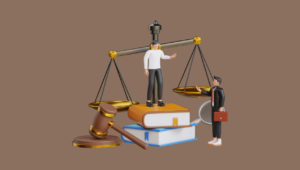In today’s rapidly digitizing world, every design choice carries weight. Beyond the obvious aesthetic appeal, there’s an intricate web of psychology at play, especially when it comes to color. The hues you choose can, often subconsciously, influence the emotions, perceptions, and ultimately, the trust of your users. Let’s dive deep into understanding how color psychology is intricately tied to user trust. In this article, we’ll go beyond aesthetics & learn how color psychology influences user trust with UX & design.
The Trustworthiness of Color Psychology
It might seem surprising, but colors have long been associated with specific emotions and ideas. Blue, for instance, is frequently linked to feelings of calm, security, and trustworthiness. It’s no coincidence that many banking and financial institutions use blue in their branding.
On the other end of the spectrum, colors like red can evoke urgency, excitement, or even caution. When used appropriately, red can prompt action — think of sale signs or urgent notifications. But overuse or misuse can be off-putting and signal danger to users.
Decoding User Perceptions Color Psychology
Before diving into color choices, it’s vital to understand your target audience. Different cultures, backgrounds, and personal experiences can lead to varying perceptions of the same color. For instance, while white is often associated with purity and peace in Western cultures, it might be linked to mourning in some Eastern traditions.
Moreover, age, gender, and even personal preferences play a role. A hue that appeals to a Gen Z user might not resonate the same way with a Baby Boomer. Designing with a holistic understanding of your user demographic can make a marked difference in trust-building.
Consistency is Key
Trust, both online and offline, is built over time through consistency. If your brand uses soothing pastel tones on its homepage, a sudden shift to neon on a product page can be jarring. Such inconsistencies can make users question the reliability of your brand or platform.
By maintaining a consistent color palette that aligns with your brand’s message and user expectations, you pave the way for increased trust. Over time, these colors become synonymous with your brand’s identity and values. In this article, we’ll go beyond aesthetics & learn how color psychology influences user trust, emotions & intentions with UX & design.
Designing with Authenticity Color Psychology
While understanding color psychology is crucial, it’s equally essential not to manipulate users overtly. Being authentic in your design choices means aligning them with your brand’s genuine values and messages. If users feel they’re being manipulated, any trust that’s been built will rapidly erode.
Consider the case of ‘greenwashing,’ where brands overemphasize their eco-friendliness using greens and earthy tones without genuine sustainable practices. Users quickly see through the facade, leading to decreased trust. In this article, we’ll go beyond aesthetics & learn how color psychology influences user trust, emotions & intentions with UX & design.
Adapt and Evolve
As with most aspects of design and marketing, staying stagnant is not an option. Continual research, feedback loops, and A/B testing can provide insights into how users are reacting to your color choices.
It’s possible that a hue that was effective a few years ago isn’t resonating the same way now. Being agile and willing to adapt your design based on user feedback can further establish trust. In this article, we’ll go beyond aesthetics & learn how color psychology influences user trust, emotions & intentions with UX & design.
Integrating Color Psychology with UX Design

The intersection of color psychology and user experience (UX) design is a crucial focal point for brands aiming to build user trust. The user’s journey, from the landing page to checkout or any other call to action, is punctuated by design elements, chief among them being color. In this article, we’ll go beyond aesthetics & learn how color psychology influences user trust, emotions & intentions with UX & design.
Emotional Triggers
Every color can act as an emotional trigger. For instance, a soft lavender or light blue might evoke feelings of serenity, making them apt choices for meditation apps or wellness websites. Meanwhile, bold shades like orange or electric blue can stimulate excitement and energy, resonating well with adventure or sports-related platforms.
CTAs and Color Choices
Call-to-Action (CTA) buttons are crucial in guiding user behavior. The color of a CTA can determine its visibility and, by extension, its click-through rate. A green ‘Proceed’ or ‘Buy Now’ button can subconsciously reassure users, signaling a safe and positive action. Conversely, a ‘Cancel’ or ‘Decline’ option in red warns users and often deters hasty decisions.
Microinteractions and Feedback
Microinteractions, like hover animations or loading indicators, can be enhanced using color. A subtle change in shade when a user hovers over a button or a colorful loading bar can provide intuitive feedback. Using reassuring colors for these interactions can further enhance user trust in Aesthetics psychology for user.
The Subtle Art of Color Transitions
The gradient trend, where one color seamlessly transitions into another, is not just a visual treat but also an exercise in combining color psychology principles. The transition from a reassuring blue to an energetic yellow, for instance, can subtly guide users from a feeling of trust to one of optimism.
Accessibility Matters Color Psychology
In our discussion about color, it’s vital to consider accessibility. A significant portion of users might have color vision deficiencies. Ensuring that your color choices are distinguishable and provide adequate contrast for all users is both an ethical and practical design approach. Platforms that prioritize accessibility inherently convey a message of inclusivity, further bolstering user trust.
Brand’s Colors
Red
- Coca-Cola: Firstly, The iconic bright red is synonymous with this global soft drink brand.
- Netflix: Secondly, the streaming giant uses red for its logo, highlighting passion and energy.
- Target: The retail giant’s red bullseye is instantly recognizable.
- Canon: The deep red represents the brand’s passion for photography.
- Toyota: The car company’s red emblem signifies quality and innovation.
- Kellogg’s: Finally, Their red logo is a nod to excitement and appetite stimulation.
Blue
- Facebook: The social media behemoth employs a calming blue, signifying trust and reliability.
- Ford: The automaker’s signature blue oval represents strength and dependability.
- Visa: Their blue accentuates trust and security, vital for financial transactions color psychology.
- Pepsi: The globally recognized blue, red, and white globe signifies refreshment.
- Dell: The technology company’s blue logo exudes reliability and professionalism.
- General Electric (GE): Finally, their blue signifies strength and dependability in various sectors.
Green
- Starbucks: The coffee giant uses a deep green, evoking a sense of freshness and sustainability.
- Spotify: Their vibrant green denotes energy and innovation in the music streaming realm.
- John Deere: This brand’s green is linked to agriculture, nature, and reliability.
- BP (British Petroleum): The green in their sunflower logo suggests environmental commitment.
- Android: The robot’s green color symbolizes innovation and growth.
- Subway: Their green logo accentuates freshness and health-conscious choices.
Yellow
- McDonald’s: The golden arches of this fast-food giant are perhaps as famous as the brand itself.
- IKEA: The Swedish company uses blue and yellow, reflecting its national colors, and the yellow brings warmth and optimism.
- National Geographic: Their yellow frame is iconic, suggesting exploration and knowledge.
- Snapchat: Their ghost logo is a bright yellow, highlighting fun and spontaneity.
- DHL: The leading logistics company’s yellow signifies speed and precision.
- Shell: The yellow and red shell is iconic, reflecting energy and innovation.
Purple
- Cadbury: The chocolatier’s royal purple indicates luxury and indulgence.
- Twitch: This streaming platform’s purple signifies creativity and innovation.
- FedEx: Their combination of purple and orange signifies precision and energy.
- Hallmark: Their crown logo in purple signifies royalty and high-quality sentiments.
- Yahoo!: The digital company’s purple exudes creativity and innovation.
- Taco Bell: While incorporating other colors, their bell often appears in purple, signifying a modern, fun dining experience. Color Psychology.
Orange
- Home Depot: The hardware store’s bold orange suggests practicality and hands-on energy.
- Amazon: While primarily black and white, the orange arrow (or smile) in their logo indicates happiness and a broad range of offerings.
- Fanta: The bubbly drink’s bright orange is as effervescent as the product itself.
- Nickelodeon: Their vibrant orange splat is synonymous with youth and creativity.
- JBL: The orange suggests energetic sound and innovation in their audio products.
- SoundCloud: The streaming platform’s orange wave represents vibrancy and community.
Black
- Apple: While Apple uses various colors, black is often associated with its sleek design ethos, suggesting sophistication and luxury.
- Nike: Their black swoosh is emblematic of style, strength, and simplicity.
- Adidas: The brand often uses black to convey strength, durability, and timeless style.
- Chanel: The luxury brand’s black and white color scheme signifies elegance and timelessness.
- Uber: Their primarily black logo conveys sophistication and premium service.
- Sony: Black is often associated with this electronics brand, denoting premium quality and innovation.
Pink
- T-Mobile: Their magenta pink is bright and bold, symbolizing innovation and disruption in the telecom industry.
- Barbie: This toy brand’s pink denotes femininity and fun.
- Lyft: The rideshare company’s pink mustache is now iconic, signaling friendliness and approachability.
- Dunkin’: Their pink and orange combo suggests warmth, fun, and delicious offerings.
- Victoria’s Secret: The lingerie brand’s pink denotes femininity and luxury.
- COSMOPOLITAN: The magazine’s pink suggests modern femininity and empowerment.
In Conclusion
Color psychology moves beyond mere aesthetics, playing a pivotal role in how users perceive and trust a brand. By understanding the emotional and cultural nuances of color, maintaining consistency, designing with authenticity, and being adaptable, brands can harness the power of color to foster deeper, more genuine user trust.
In the era of digital transformation, where the smallest details can sway user decisions, understanding the deeper implications of color can be a game-changer for businesses and designers alike.








